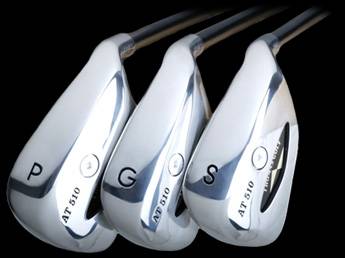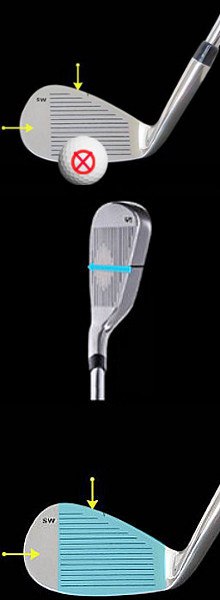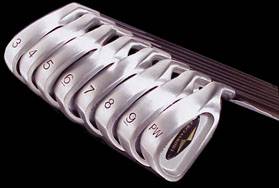When hitting from tee to fairway or fairway to green, there are typically two or three options for club selection and shot type. One of golf's ironies is that the shorter the distance between ball and hole, the more choices present themselves.
The number of different ways to play a chip or pitch shot can twist the mind in knots. Indecision ensues, which inevitably leads to a lack of confidence and poor results.
There's a way around the issue. Rather than making your entire bag of clubs available for any given short-game attempt, limit your choices to no more than three clubs. For example, the sand or lob wedge, gap wedge (53-55° loft) and 7-iron.
You'll only pull the 7-iron for long chips with plenty of green to work with. Use the sand or lob wedge when you need to get the ball up high and land it softly. The gap wedge is the choice for all other shots.
By cutting your short-game arsenal to a few clubs, you'll not only eliminate indecision, you'll learn to play a variety of shots with each club – especially the gap wedge. With practice, you'll become skilled at changing the trajectory and distance based on the shot's requirements, gaining consistency and confidence.
Generally speaking, it is a good think of having options on the golf course.

Golf is a game which presents you with many challenges during each round, so you want to have plenty of options at your disposal in order to deal with those challenges. Usually, the player with the greatest number of different shots in his or her bag is going to be at a significant advantage.
With that said, there are some instances where options can be a bad thing. In this article, we are going to talk about how limiting your options in the short game may actually help you to perform at a higher level. Specifically, we are going to talk about the strategy of limiting how many different clubs you use to hit chip and pitch shots. By narrowing down the list of clubs that you deploy for this purpose, your game may actually take a big step forward.
At first, you might think that limiting the number of clubs you use in the short game will limit the types of shots you can play. However, we hope to explain that this is not actually the case. With a little creativity – and plenty of practice – you should be able to create many different kinds of short game shots with just a couple of clubs. Not only that, but you will probably be more consistent thanks to the simplicity that you will have added to your game.
It should be noted that nothing is going to improve with regard to your short game unless you decide to practice. Plenty of amateur golfers basically ignore the short game when they practice, instead opting to hit a bunch of drives as far down the range as possible. That may be fun for a while, but it isn't doing much to make you a better player. If you are serious about lower scores, you are going to be serious about improving your short game. It's just that simple.
All of the content below is based on a right-handed golfer. If you happen to play left-handed, please take a moment to reverse the directions as necessary.
Building a Strong Relationship

To start with, we want to emphasize the powerful potential of developing a strong relationship with one specific short game club. If you have one club which you turn to time after time, you will be likely to achieve at least a modest degree of success. This all comes down to familiarity, and confidence. By using the same club on most of your short game shots, you are going to learn quickly just what that club can and can't do. You'll almost certainly get better at using this club over time, and you'll begin to chip the ball closer to the hole on a regular basis.
Unfortunately, this is not the advice that you will receive from many golf instructors. Often, golf teachers will tell their students that they need to use a variety of clubs, picking the right one based on the shot at hand. This is a plan that can work nicely for professional golfers – who practice for hours each day – but we don't think it is the best way to go for the amateur player. If you are a typical amateur who is lucky to practice once or twice a month, opting to handle most of your chip shots with the same club is a smart strategy.
So, which club should you choose? Well, let's look at a list of characteristics that this club is going to need to possess.
- Plenty of loft. Without a doubt, your go-to chipping club of choice is going to need to be one which offers plenty of loft. Since this club is going to need to deal with a variety of situations properly, you can't opt for something with too little loft to get the ball up in the air with ease. In fact, we would suggest that you eliminate everything from your pitching wedge on down. Most pitching wedges have somewhere around 48* of loft, and that just isn't enough to deal with the many shots you are going to encounter.
- The ability to hit low chips/pitches. While we don't want you to use a club with too little loft, you do need to select a club that it going to allow you to play the ball low to the turf from time to time. It is possible to play low shots with the right technique, even if your club has a significant amount of loft. However, at some point, you just have too much loft to make a low shot a particularly viable option. We would recommend eliminating a 60* wedge from this discussion (or anything you might have with more than 60* of loft).
- A versatile bounce angle. The 'bounce' on your wedges is the rounded part of the sole. A club with a significantly rounded sole will have a higher bounce angle than a club with a sole that runs mostly flat from the leading edge to the back of the club head. In most cases, you are going to want to opt for a club with a bounce angle that comes in somewhere in between those two extremes. If you use too much bounce on your go-to wedge, it will be hard to use the club from tight lies. On the other hand, too little bounce will cause the club to dig in easily when the turf gets soft. Try a wedge with either 6* or 8* of bounce and you are likely to be happy with the results.
Pretty quickly, we have narrowed down the possibilities for your go-to chipping club. In our opinion, you should settle on either a 56* or 58* wedge for this job. If you tend to play golf courses without dramatic elevation changes around the greens, go for the 56*. On the other hand, if you regularly play courses with rather severe terrain, the 58* may be the right call. In the end, the two degrees of loft difference between these options isn't going to make a huge difference, so pick the one which gives you the most confidence.
Once you have decided which club is going to be your standard option for most short game shots, there is only one thing left to do – get down to work. You will want to develop the strongest possible relationship with this wedge, and that is only going to happen through consistent practice. With each shot you hit in practice, you will gain just a bit of confidence and experience. Over time, those practice sessions are going to add up to something powerful. It is a great feeling to know that you can turn to a trusted club to handle the majority of your short game challenges on the course.
Adding an Alternative

While we are highlighting the value of using a single club for most of your chip shots, it does need to be said that you should have another option in mind for certain occasions. As a rough estimate, you may be able to handle something like 80% of your chip and pitch shots with your chosen go-to club. That leaves roughly 20% of the shots remaining, which means you need to have a plan for those situations as well. Most likely, you are going to want to use a lower-lofted club in those other situations.
Our recommendation is to get comfortable hitting low chip and pitch shots with your pitching wedge. The pitching wedge has enough loft to get the ball up into the air from most lies, and yet it allows you to play a shot that will bounce and roll nicely toward the hole. You can think of your pitching wedge as your fallback plan for situations where your standard club just doesn't feel right. One example would be a chip/pitch shot which needs to be played uphill, all the way across the green. In that situation, it may be hard to carry your 56* or 58* wedge far enough to reach the hole comfortably. Using your pitching wedge instead, you can run the ball up the slope and hopefully leave the ball near the target.
It is also a good idea to have a lower-lofted alternative in mind in case you have a bad lie. It's difficult to pick a chip shot cleanly off the turf when your lie is bad, but punching such a shot with your pitching wedge isn't too difficult at all. If you were to play 100% of your shots around the green with a 56* or 58* wedge, you'd quickly find yourself in trouble when you have a bad lie. You might not turn to your pitching wedge all that often for chip and pitch shots, but it is valuable to know how to use it just in case.
To help you get the best possible results when chipping with a pitching wedge, we have outlined a few tips below.
- Less hand action. When you chip with a highly-lofted club, such as a 56* or 58* wedge, you will probably use a bit of hand action to move the club through the ball. This is okay, and it can help you generate backspin which can be used to stop the shot quickly after it lands. However, when you go down to your pitching wedge for a chip shot, you want to take most – or all – of that hand action out of the swing. Instead, you should keep your hands quiet through the hitting area, maintaining a firm left wrist at the point of contact. This is going to promote a solid strike, and it is going to help you drive the ball toward the target on a low trajectory. If necessary, consider turning your left hand into a weaker position on the grip in order to promote quieter hands and wrists during the swing. By a 'weaker' position, we mean you should turn your left hand a bit to the left from where it would normally sit on the grip.
- Play the ball back in your stance. In most cases, you are going to want to hit down on the ball slightly when playing this kind of chip shot. You'll usually use a flatter swing through the ball with a sand wedge or lob wedge, but hitting down with your pitching wedge should produce nice results. In fact, if you can combine a downward angle of attack with quiet hands through the ball, you'll be well on your way to consistent performance. One of the easiest ways to make sure you hit down on the ball is simply to move the ball back in your stance at address. Play these shots from just behind the middle of your stance and you should be set up for success.
- Use less swing. This might be an obvious point, but you will usually need less of a swing when playing a chip shot with a pitching wedge (as compared to a club with more loft). The ball is going to come out lower, and it is going to have very little backspin. Most of the time, that means the ball will bounce and roll a significant distance. It is up to you to pick the right landing spot for this kind of shot, allowing the ball all the room it needs to come to a stop. If you don't feel like you have enough room available to bring the ball to rest near the hole, you will probably need to change clubs and use more loft.
- The way we see it, you should have two clubs which handle nearly every chip or pitch shot you encounter on the course. The higher-lofted club – a 56* or 58* wedge – will be responsible for most of the shots, and it will be your default choice. From there, you will go down to a pitching wedge when your higher-lofted club just isn't going to be a good fit for the job. Using this approach is going to keep things simple around the greens while still giving you all the versatility needed to produce great results.
Is it possible to build a solid short game by using a wide range of clubs for your chip and pitch shots? Sure, it's possible. Plenty of professional golfers use this strategy, and many amateurs as well. However, we think it is going to be more difficult to succeed that way, especially if you have limited practice time from week to week. If you choose to build a strong relationship with one specific wedge, and you use that wedge for most of your shots, we think you will have better success over the long run. Of course, as was mentioned earlier, having an alternative club to turn to when your go-to option isn't a good fit is an important piece of the puzzle.
The short game is tremendously important when it comes to determining your score for a given round of golf. It is great to improve your full swing, but nothing impacts your scores quite like the short game. Improve on your chipping ability by limiting the number of clubs you use, and it's likely that your scores are going to move in the right direction. Then, if you can add some quality putting on top of your improved chipping, you will really be onto something. Good luck!







